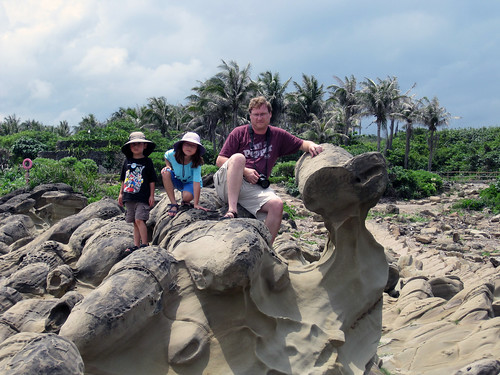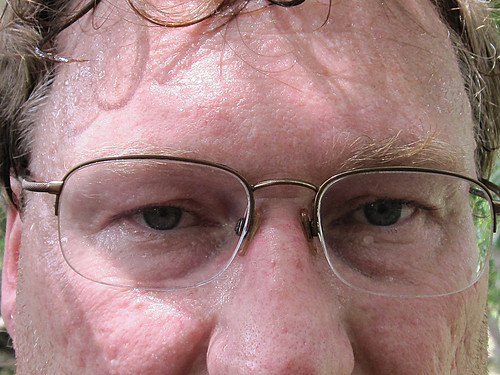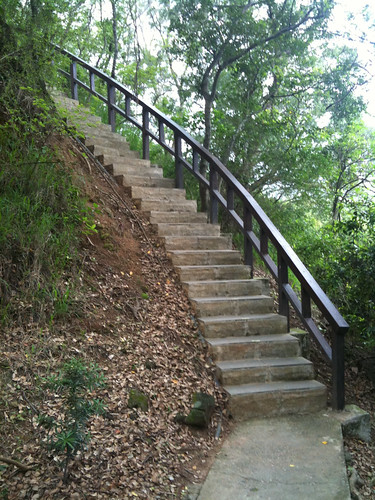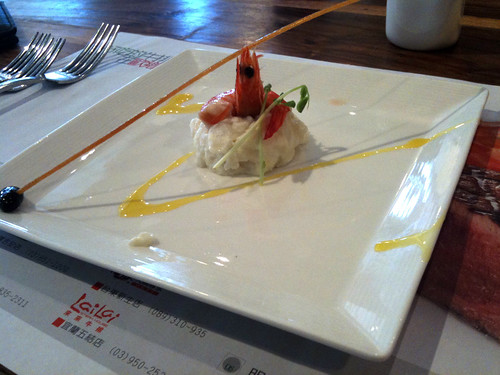At last I’ve finally caught up. All that cow excitement was beginning to make me fall behind, but I’ve got a couple more hours on the train from Taitung to Taipei and nothing to do except burn out my batteries. Michelle has exhausted all but the last of my iPhone’s battery playing Monopoly and now she’s working on the iPad’s battery reading The Lightening Thief.
Last time I blogged some photos of our wonderful, Japanese-style spa room. The whole resort is built about the spa, but we weren’t able to go last night as a thunderstorm came up, and I wasn’t too keen to be sitting in the water during an electrical storm. In the morning, the spa didn’t open early enough, and by the time it did, it was raining again.
No doubt I’ve mentioned before that Taiwan has an extremely poor track record of “romanizing” their language into western characters. Whereas China simply issued a decree and forced everyone (on pain of death, no doubt) to use a newly-developed system called Pinyin, Taiwan never went through that phase, and they’ve been damn stubborn about adopting the Chinese system because… well.. because it’s Chinese and they’re not Chinese enough. (I kid you not.)
Consequently, Taiwan has been using the old Wade-Giles system, which, to my uneducated eye, sucks. Now, I’m sure Messrs. Wade and Giles knew a lot more about language than I do, but I do know one thing: If you use their system of romanizing and you try to pronounce the word, no Chinese speaking person will ever understand what you’re trying to say.
Let me demonstrate. Take for example these two words, “Peking” and “Beijing.” Those are two words you’ve probably heard before. Everyone has heard of Peking Duck and everyone knows the capital of China is Beijing. Here’s a dirty little secret: They’re the same word using the two different romanization systems and they’re pronounced the same way. What you know as Peking Duck should be pronounced more like Beijing Duck. (Although they have their own word for “duck”, too.) “Taipei” become “Daibei” and my wife’s name, Chu-Wan, would become “Zhuwan” and she’d immediately move to the back of the alphabet.
Taiwan is slowly adopting the Chinese system, mostly because it’s all that’s taught in schools and universities around the world anymore. If you want foreigners to read your romanized text and be able to do business in Taiwan, you must use the Chinese Pinyin system. There’s another problem with the older Wade-Giles system – apparently no one in Taiwan knew how to use it either.
I mention all this because we spent a long time today driving around Taitung (Daidong) and so no fewer than 7 spellings for “Jhihben” on official signs. I have no clue how it would properly be spelled, but I think it would be “zhiben.” I never saw it spelled that way, though.
I also mentioned all that because much of the day was spent driving around in circles.
After we checked out of our room (I’ll miss it!) we drove out towards the beach where sunrise first greats Taiwan each morning and that on Jan 1, 2000 it was packed with thousands of people. Fortunately, it wasn’t at sunrise when we arrived. I’ve seen more “special” sunrises in Taiwan than I’ve seen cows, and that’s saying a lot.Not only is it a rocky, nasty beach, cluttered with a huge accumulation of garbage, but it doesn’t even appear to be the easternmost point on the island, which would seem to me to be the point that would see the sunrise first.
Afterwards, we stopped at Xiaoyehlieu (or is that hsiaoyehlieu?) which is a series of interesting rock formations on the coast. There’s a similar, larger formation on the northern coast called Yehlieu.
By this time, I was completely knackered. It’s hot and oppressively humid. (I’ve included this picture of me sweating by way of demonstration.) I settled into the car and started watching the Man From Atlantis on my iPad. I was only vaguely aware of what was going on. Periodically, I’d look up and spot a new spelling of Jhihben but otherwise, as far as I could tell, we were just driving around in circles in Taitung. Like any city in Taiwan, it’s hardly picturesque.
Eventually, we decided to eat before our train ride back to Taipei, but it was a little too early, so we stopped at a nearby park, which, like seemingly all parks of interest in these southern towns, was a great big set of stairs…and mosquitoes. Lots of mosquitoes. They didn’t even bother to run when you swatted at them, They just dropped their little mosquito pants, waved their privates parts at us in defiance and attacked again. It was, as usual, a nice view at the top, but I wonder if it was worth the bloodletting.
We stopped at a steakhouse we’d seen the day before. They had a distinctly American sales gimmick of selling a 1 Kilogram steak, which, if you could eat the whole thing, you got for half price. I didn’t try that, but I did figure this would be a very down-to-earth steakhouse. Was I wrong! It’s was one of the most pretentious steak places yet. Every course was served with a flourish of pretense of a high-end restaurant wishing to charge ridiculous prices for nothing of substance, yet this was, as far as I could tell, just a low-end Taiwanese-style steak shop. Here’s a picture of the prawn appetizer, with its single stick of fried spaghetti.
At lunch, I learned the truth about our earlier excursion around Taitung: We were just driving in circles. A few years ago, they moved the train station and my father-in-law wanted to locate the station for later. He never found it. At lunch, no fewer than three people gave us directions to the stations, none of which seemed to make sense. Whipping out the iPhone and the GPS, I quickly located the train station and we had no further trouble locating it. Score one for technology, none for human interaction.
It’s a full four hours back to Taipei on the slow (but not slowest) train. The east coast simply isn’t populated enough for a high speed train like on the west coast, but they do have some of the new “rocking trains” which I’m not too familiar with, but I understand they achieve their extra speed by not slowing down on turns. The rocking train was my requirement for this trip as I’m fascinated by different forms of train technology; unfortunately, these trains are popular and no seats were available. We were stuck on an “express” train which achieves a bit of speed by not stopping at many stations. It’s still painfully slow.
And so ended our mini-trip to the rift valley of Taiwan.




